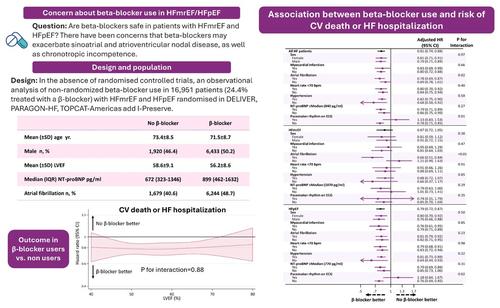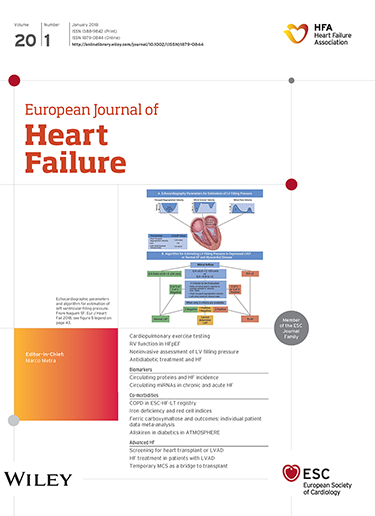Beta‐blocker use and outcomes in patients with heart failure and mildly reduced and preserved ejection fraction
IF 16.9
1区 医学
Q1 CARDIAC & CARDIOVASCULAR SYSTEMS
引用次数: 0
Abstract
AimsIn the absence of randomized trial evidence, we performed a large observational analysis of the association between beta‐blocker (BB) use and clinical outcomes in patients with heart failure (HF) and mildly reduced (HFmrEF) and preserved ejection fraction (HFpEF).Methods and resultsWe pooled individual patient data from four large HFmrEF/HFpEF trials (I‐Preserve, TOPCAT, PARAGON‐HF, and DELIVER). The primary outcome was the composite of cardiovascular death or HF hospitalization. Among the 16 951 patients included, the mean left ventricular ejection fraction (LVEF) was 56.8%, and 13 400 (79.1%) had HFpEF (LVEF ≥50%). Overall, 12 812 patients (75.6%) received a BB. The median bisoprolol‐equivalent dose of BB was 5.0 (Q1–Q3: 2.5–5.0) mg with BB continuation rates of 93.1% at 2 years (in survivors). The unadjusted hazard ratio (HR) for the primary outcome did not differ between BB users and non‐users (HR 0.98, 95% confidence interval [CI] 0.91–1.05), but the adjusted HR was lower in BB users than non‐users (0.81, 95% CI 0.74–0.88), and this association was maintained across LVEF (

心力衰竭、射血分数轻度减低和保留患者使用β-受体阻滞剂的情况和预后
目的 在缺乏随机试验证据的情况下,我们对心力衰竭(HF)、射血分数轻度降低(HFmrEF)和射血分数保留(HFpEF)患者使用β-受体阻滞剂(BB)与临床结局之间的关系进行了一项大型观察性分析。主要结果是心血管死亡或高频住院的复合结果。在纳入的 16 951 名患者中,平均左心室射血分数(LVEF)为 56.8%,13 400 人(79.1%)患有 HFpEF(LVEF ≥50%)。共有 12 812 名患者(75.6%)接受了 BB 治疗。BB的中位比索洛尔等效剂量为5.0(Q1-Q3:2.5-5.0)毫克,2年内(幸存者)BB持续率为93.1%。主要结局的未调整危险比(HR)在BB使用者和非使用者之间没有差异(HR 0.98,95% 置信区间 [CI]0.91-1.05),但BB使用者的调整后HR低于非使用者(0.81,95% CI 0.74-0.88),这种关联在LVEF不同的情况下保持不变(pinteraction = 0.88)。在亚组分析中,无论是否有心肌梗死病史、高血压或基线心率为 70 bpm,BB 使用者和非使用者的主要结局调整风险相似。结论在这项非随机BB治疗的观察性分析中,即使对其他预后变量进行了广泛调整,也没有发现使用BB与HFmrEF/HFpEF患者较差的HF预后有关。
本文章由计算机程序翻译,如有差异,请以英文原文为准。
求助全文
约1分钟内获得全文
求助全文
来源期刊

European Journal of Heart Failure
医学-心血管系统
CiteScore
27.30
自引率
11.50%
发文量
365
审稿时长
1 months
期刊介绍:
European Journal of Heart Failure is an international journal dedicated to advancing knowledge in the field of heart failure management. The journal publishes reviews and editorials aimed at improving understanding, prevention, investigation, and treatment of heart failure. It covers various disciplines such as molecular and cellular biology, pathology, physiology, electrophysiology, pharmacology, clinical sciences, social sciences, and population sciences. The journal welcomes submissions of manuscripts on basic, clinical, and population sciences, as well as original contributions on nursing, care of the elderly, primary care, health economics, and other related specialist fields. It is published monthly and has a readership that includes cardiologists, emergency room physicians, intensivists, internists, general physicians, cardiac nurses, diabetologists, epidemiologists, basic scientists focusing on cardiovascular research, and those working in rehabilitation. The journal is abstracted and indexed in various databases such as Academic Search, Embase, MEDLINE/PubMed, and Science Citation Index.
 求助内容:
求助内容: 应助结果提醒方式:
应助结果提醒方式:


